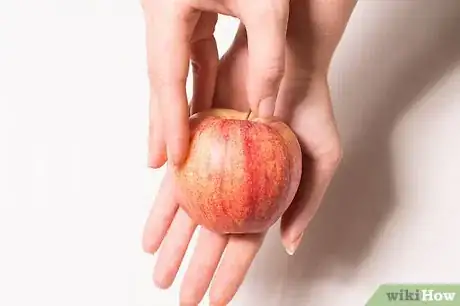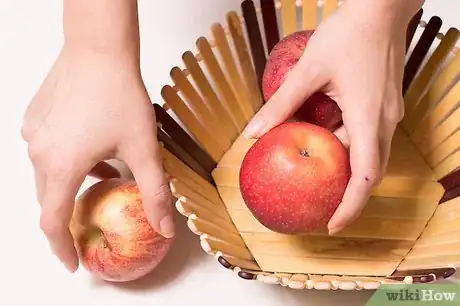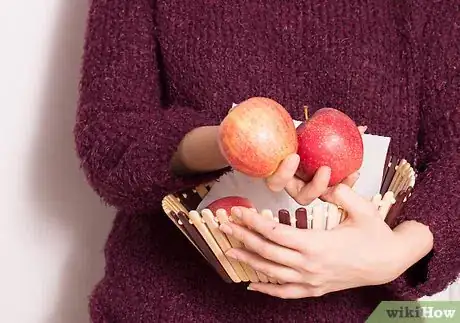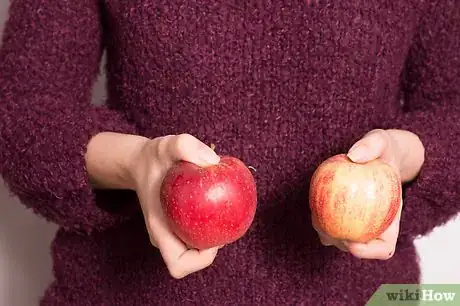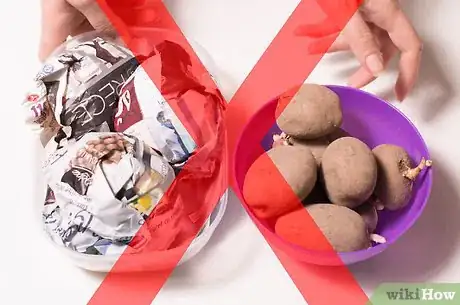wikiHow is a “wiki,” similar to Wikipedia, which means that many of our articles are co-written by multiple authors. To create this article, 11 people, some anonymous, worked to edit and improve it over time.
There are 8 references cited in this article, which can be found at the bottom of the page.
The wikiHow Culinary Team also followed the article's instructions and verified that they work.
This article has been viewed 370,484 times.
Learn more...
Apples require a little bit of coolness in order to stay fresh in storage for a longer period of time. Cool temperatures alone are often enough to keep your apples fresh weeks, but if you take a few extra precautions, you can even store apples up to several months.
Steps
Short-Term
-
1Start with apples that are in good shape.[1] Inspect your selection of apples and separate the apples that have bruises or soft spots from the apples that are still undamaged. One bad apple really can rot the bunch because apples produce a large amount of ethylene gas as they decay. As a result, you should not store damaged apples with undamaged apples.
-
2Place damaged apples out on the counter. When kept at room temperature in a basket, apples can stay fresh for about two days.[2] This is not a long time, of course, but damaged apples should be eaten within a short amount of time no matter how you store them since a partially decayed apple is likely to spoil faster.[3]
- If the apples are too damaged for human consumption, you could also consider throwing them out into the woods for deer or other wildlife to enjoy. Even if no wild animal is interested, as the apples decay, they will provide a food source for various insects and other organisms living in the dirt.
Advertisement -
3Pile good apples into the refrigerator.[4] Apples stay fresher for a longer period of time when kept a little cold. Most modern refrigerators have a fruit drawer or crisper drawer, and if your refrigerator has a drawer like this, you should store your apples there. If not, place the apples in an uncovered plastic container near the back of the refrigerator, where it tends to be coldest.
-
4Drape a damp paper towel over the apples in the refrigerator. Aside from cold temperatures, apples also need a small amount of moisture to stay their freshest. Laying a damp paper towel over the apples provides just enough moisture,[5] but if you do cover the apples with a wet paper towel, you need to make sure that you do not seal them in an airtight container or drawer.
-
5Monitor the temperature, if possible. If you have a temperature control dial for your crisper drawer, set it to a temperature between 30 and 35 degrees Fahrenheit (-1.1 to 1.7 degrees Celsius). This is the ideal temperature range for apples to be stored at. Storing them in colder conditions will cause the cells to break down, leading to mushy, inedible apples, and storing them in conditions that are warmer by only 10 degrees Fahrenheit (12.2 degrees Celsius) can cause the apples to ripen twice as quickly.
- If you do not have temperature control settings that allow you to control the temperature by degrees, but you do have basic settings that allow you to make the refrigerator or crisper drawer colder or warmer, place a thermometer in the drawer and adjust the settings until the thermometer shows a number within the appropriate range.
-
6Keep an eye on your apples. Stored this way, apples can stay fresh for up to three weeks.
Long-Term
-
1Start with long-keeping apple varieties. Tart, thick-skinned apples like Jonathans, Rome, Melrose, Fuji, and Granny Smiths are usually your best bet.[6] Sweet, thin-skinned apples, like Red Delicious or Golden Delicious, do not generally do as well.
- Also make sure that your apples are in good shape. Apples with soft spots or bruises give off a lot of ethylene gas, which can cause nearby apples to decay faster than normal and may thwart your storage efforts.
-
2Wrap each apple individually.[7] Even apples that are in good shape give off a little ethylene gas, and as a result, apples that rub up against each other as they are in storage are more likely to rot faster. Moreover, if one apple starts to rot while it is in storage, it could contaminate the other apples it touches, causing the entire bunch to spoil faster. Wrapping each apple individually prevents most of the potential damage caused when apples come into contact with each other.
- Separate a section of newspaper into quarters and stack those quarters together. Choose a section that only has black ink since colored ink contains poisonous heavy metals.
- Place one apple on top of the stack of newsprint. Bring the top sheet up and fold it around the apple, gently twisting the corners together the keep the apple wrapped. Do not twist too tightly, since you may tear the paper if you do. The objective is only to prevent the apple from coming into contact with other apples, not to keep the air out.
- Continue wrapping each apple in a quarter sheet of newsprint until the entire bunch has been covered.
-
3Line a crate or cardboard box with insulation.[8] The container should not be airtight, since you do not want to completely restrict airflow to your apples as you store them, but it should keep out most of the air. Insulating the box also helps regulate the temperature of your apples and the amount of airflow it receives. Line the containers with straw or perforated plastic liners.
-
4Place your apples in the insulated container. Line them up side by side, making sure that the newsprint wrappings do not come undone and that the apples are not directly touching skin to skin.
-
5Store the apples in a cold location. A root cellar is the most common location of choice, but an unheated basement, unheated attic, or enclosed porch can also work just as well. The average temperature of the area should not drop too far below freezing, however, since the freezing process will rupture the cells of your apples, turning them to mush when they thaw.
-
6Do no store apples near potatoes. Potatoes release a gas as they age, and this gas can cause apples to rot faster. You can keep the two types of produce in the same room or storage facility, but do not keep them side by side.
-
7Check your apples after a few months. Stored this way, apples can retain their freshness for several months, but will start to go bad after that.
Community Q&A
-
QuestionWhat is the best way to store a cut apple?
 Community AnswerLightly coat the apple in lemon juice and put in a sealed container in the fridge. The lemon juice will prevent the apple from turning brown!
Community AnswerLightly coat the apple in lemon juice and put in a sealed container in the fridge. The lemon juice will prevent the apple from turning brown! -
QuestionCan I store a half eaten apple?
 Community AnswerCover with cling film and refrigerate for no longer than 1 day if you want to eat as fruit. If you would be using it in a recipe such as the worlds tiniest apple pie, you can cut into small pieces and freeze in a zip lock or plastic for a long time.
Community AnswerCover with cling film and refrigerate for no longer than 1 day if you want to eat as fruit. If you would be using it in a recipe such as the worlds tiniest apple pie, you can cut into small pieces and freeze in a zip lock or plastic for a long time. -
QuestionCan I store a box of apples on a concrete floor?
 Community AnswerAs long as there are no "pests" in the garage/storage unit/shed and as long as the apples are not in danger of freezing.
Community AnswerAs long as there are no "pests" in the garage/storage unit/shed and as long as the apples are not in danger of freezing.
Things You’ll Need
- Thermometer
- Newsprint
- Crate or cardboard box
- Straw or perforated plastic lining
References
- ↑ https://www.thekitchn.com/how-to-store-apples-for-the-wi-68778
- ↑ https://www.stilltasty.com/fooditems/index/16383
- ↑ https://wilkes.ces.ncsu.edu/2015/10/what-is-the-best-way-to-store-apples/
- ↑ http://simplystated.realsimple.com/2011/11/17/how-to-store-apples/
- ↑ https://www.insider.com/how-to-store-apples-and-keep-them-fresh-2017-10
- ↑ https://www.cookinglight.com/cooking-101/essential-ingredients/how-to-store-apples
- ↑ http://www.backwoodshome.com/articles/fallick41.html
- ↑ https://www.rhs.org.uk/advice/profile?pid=595
About This Article
If you want to store apples for a few weeks, put them in the fridge in an uncovered plastic container. You can also place a damp paper towel over the apples, which will help them last longer because of the moisture. If you want to store apples for several months, start by wrapping each apple individually with newspaper. Then, line a resealable plastic container with more newspaper so it's insulated. Set the wrapped apples inside. Store the container in a cold spot, like a root cellar or basement.
